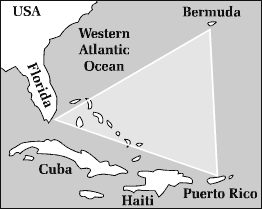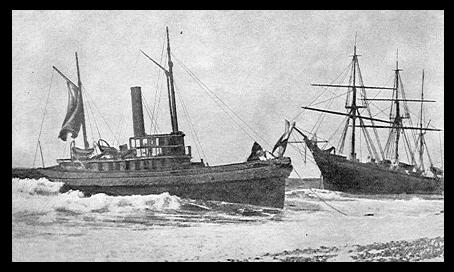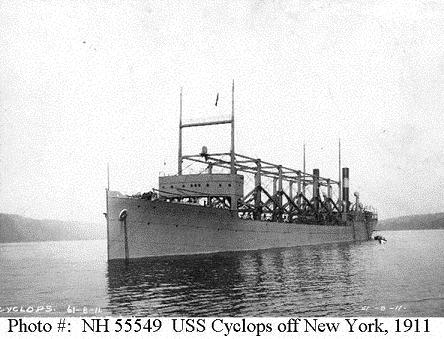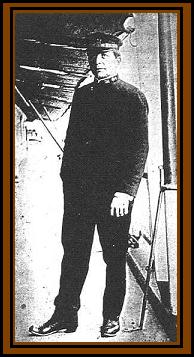United States Navy

USS CYCLOPS - USS NINA "Lost in the Bermuda Triangle"
~*~
USS Niña

USS Niña | |



USS Niña | |
| Displacement (tons) | 420 | Built / Launched | 1864 / 5/27/1865 | |
| Length | 137 | Built By | Reaney, Son, and Archbold, Chester, Pa. | |
| Beam | 26 | Class | Palos | |
| Draft | 9' 10" | Commisioned | 1905 | |
| Speed (rated) | 10.35K | Struck | 1910 | |
| Compliment | n/a | Disposition | Lost at Sea |

The ironclad steamer Kickapoo (q.v.) carried the name Cyclops from 15 June to 10 August 1869, then was renamed Kewaydin.
~~
USS Cyclops #2
(Collier: full load displacement 19,360; length 542'; beam 65'; draft 27'8"; speed 15 knots.; complement 236)
The second Cyclops, a collier, was launched 7 May 1910 by William Cramp and Sons, Philadelphia, Pa., and placed in service 7 November 1910, G. W. Worley, Master, Navy Auxiliary Service, in charge. Operating with the Naval Auxiliary Service, Atlantic Fleet, the collier voyaged in the Baltic during May to July 1911 to supply 2d Division ships. Returning to Norfolk, she operated on the east coast from Newport to the Caribbean servicing the fleet. During the troubled conditions in Mexico in 1914 and 1915, she coaled ships on patrol there and received the thanks of the State Department for cooperation in bringing refugees from Tampico to New Orleans.
With American entry into World War I, Cyclops was commissioned 1 May l917, Lieutenant Commander G. W. Worley in command. She joined a convoy for St. Nazaire, France, in June 1917, returning to the east coast in July. Except for a voyage to Halifax, Nova Scotia, she served along the east coast until 9 January 1918 when she was assigned to Naval Overseas Transportation Service. She then sailed to Brazilian waters to fuel British ships in the south Atlantic, receiving the thanks of the State Department and Commander-in-Chief, Pacific. She put to sea from Rio de Janiero 16 February 1918 and after touching at Barbados on 3 and 4 March, was never heard from again. Her loss with all 306 crew and passengers, without a trace, is one of the sea's unsolved mysteries.
~*~
USS Cyclops was the Navy's second ship of that name. A 19,360-ton collier, specially designed to keep a mobile battlefleet supplied with fuel, she was built in 1910 by William Cramp and Sons at Philadelphia, Pennsylvania. Prior to World War I, she supported U.S. warships in European waters, off the Atlantic seaboard and in the Caribbean as a unit of the Naval Auxiliary Force.
Cyclops entered commissioned service in 1917, and continued carrying coal and other cargo to facilitate the U.S. Navy's wartime operations. In early March 1918, while returning from a voyage to Brazil, USS Cyclops disappeared with all hands. Her wreck has never been found, and the cause of her loss remains unknown.
She joined a convoy for St. Nazaire, France, in June 1917, returning to the east coast in July. Except for a voyage to Halifax, Nova Scotia, she served along the east coast until 9 January 1918 when she was assigned to Naval Overseas Transportation Service.
In early March 1918, she set sail from the coast of Brazil bound for Baltimore, Maryland.
She was captained by the eccentric Lieutenant Commander George W. Worley. On March 13, when the ship was long overdue, a massive search ensued but no trace of the largest ship in the Navy or the 300 people on board were ever found
The date of death for the 21 officers and 285 enlisted men, serving on Cyclops, is designated as 14 June 1918.
The Navy had to follow up ever possibility with an investigation. Their task was to be Herculean, spanning a decade, several continents, and thousands of people; and to this day there is evidence to suggest almost every theory under the sun. Yet none could ever be proven, for no trace of the Cyclops has ever been found: not one survivor; not one shred. Their results, now amassed at the National Archives in Washington, contain about 1,500 pages of interviews, investigations and testimony.
